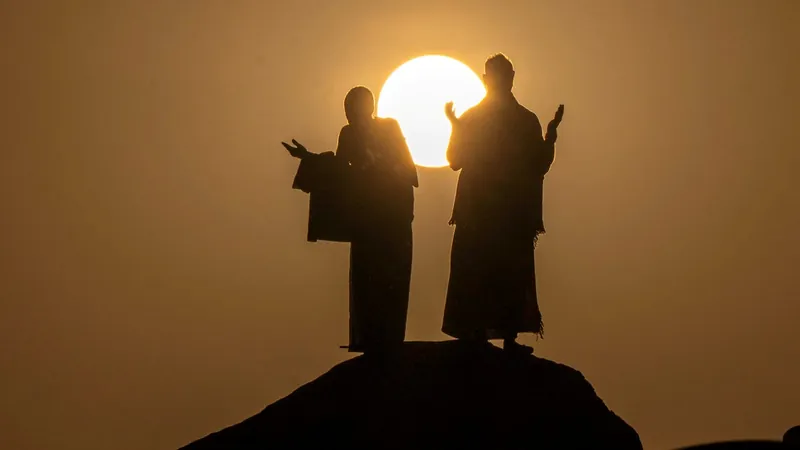
Glaciers Are 'Bleeding'—A Disturbing Sign of Climate Change!
2025-04-18
Author: Ming
The Alarming Transformation of Our Glaciers
Glaciers, once pristine giants of ice, are now showing disturbing signs of distress with strange red patches—an ominous warning of the ecological crises we face. This phenomenon, known as 'bleeding glaciers,' reveals deeper problems that demand our immediate attention as the planet endures unprecedented climate challenges.
What Is Causing the Eerie Red Stains?
The unsettling red marks on glaciers, often referred to as 'watermelon snow' or 'glacier blood,' stem from microscopic algae blooms. The key player here is Chlamydomonas nivalis, thriving in warming temperatures during summer months in polar regions. These tiny organisms produce a vibrant red pigment as a defense against harsh ultraviolet rays.
Researchers from the University of the Basque Country have observed a surge in these alarming occurrences. Leading scientist José Ignacio García warns that the blooms are directly connected to rising temperatures. This striking red hue is more than just a curious sight; it signals the dangerous feedback loops exacerbating the ongoing climate crisis as CO₂ levels skyrocket.
The Alarming Spread of Algal Blooms
A recent study from Simon Fraser University highlights that these algae now cover up to 65% of certain glaciers in North America's Northwest—transforming isolated observations into a critical climate indicator.
Why Are Glaciers Essential for Our Planet?
Glaciers form over centuries as layers of snow accumulate, compacting into dense ice under their weight. These majestic structures, found in frigid regions like the Himalayas, Arctic, Alps, and Antarctica, are not just beautiful—they're vital. They hold about 69% of the Earth's freshwater and shape landscapes, serving as natural reservoirs.
Moreover, glaciers offer essential climate data. By analyzing ice cores from ancient glacial formations, scientists can trace atmospheric changes over time, providing crucial insights into our planet's climatic history.
The Dangerous Feedback Loop
The reddish tint emerging on glaciers forms a perilous cycle that speeds up their melting. Clean, white snow reflects solar radiation, maintaining a lower temperature. However, when algae bloom, the surface darkens, absorbing more heat and accelerating melt rates.
This darker surface leads to even more algal growth, creating a self-reinforcing cycle of destruction that terrifies climate scientists. Such developments are similar to how scientists study vast cosmic events, though on a vastly different scale.
Implications for Our Planet's Future
The 'bleeding glacier' phenomenon isn’t just a local curiosity—it signifies significant planetary changes. As these ice giants melt, sea levels rise, threatening coastal communities around the globe. Freshwater supplies for areas dependent on glacial melt face severe risk, posing potential resource conflicts.
Additionally, the retreat of glaciers disrupts marine ecosystems by altering ocean temperatures and circulation patterns, impacting everything from tiny plankton to apex predators. The rapid shifts in these environments echo ancient oceanic ecosystems, leaving us with a striking reminder of the fragility of our planet.
Urgent Action Needed!
Scientists stress that this red warning sign calls for immediate action. By understanding the connection between these algal blooms and climate change, we can develop strategies to mitigate their effects and protect these critical ice formations for future generations. It's time we pay attention and act!


 Brasil (PT)
Brasil (PT)
 Canada (EN)
Canada (EN)
 Chile (ES)
Chile (ES)
 Česko (CS)
Česko (CS)
 대한민국 (KO)
대한민국 (KO)
 España (ES)
España (ES)
 France (FR)
France (FR)
 Hong Kong (EN)
Hong Kong (EN)
 Italia (IT)
Italia (IT)
 日本 (JA)
日本 (JA)
 Magyarország (HU)
Magyarország (HU)
 Norge (NO)
Norge (NO)
 Polska (PL)
Polska (PL)
 Schweiz (DE)
Schweiz (DE)
 Singapore (EN)
Singapore (EN)
 Sverige (SV)
Sverige (SV)
 Suomi (FI)
Suomi (FI)
 Türkiye (TR)
Türkiye (TR)
 الإمارات العربية المتحدة (AR)
الإمارات العربية المتحدة (AR)